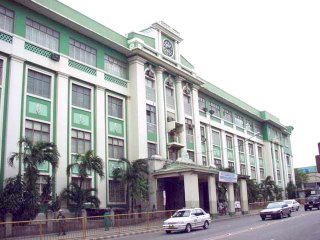 I don’t want to romanticize the way my life revolved around this street but someone else beat me to it. The artist Celso Pepito - who used to have an art gallery in what is now ‘Till Dawn convenience store – used to tell me his fondness for this street.
I don’t want to romanticize the way my life revolved around this street but someone else beat me to it. The artist Celso Pepito - who used to have an art gallery in what is now ‘Till Dawn convenience store – used to tell me his fondness for this street.The buildings here are of relatively recent construction. Among the architecturally and culturally significant buildings in this street are the exceptionally modern Sto. Rosario Church (but which now has an eclectic look inside) and the classic building of the University of San Carlos.
The school's history is worth discussing here in detail as its past was deeply interwoven with the city's history.
The university traces its roots to the Jesuit founded grammar school of old Parian in the 16th century and was instrumental in the Christianization of the Chinese settlers of Parian. In 1595, Jesuits priests Antonio Sedeno, Pedro Chirino, and Antonio Pereira came to Cebu and established the school. In Fr. Pedro Chirino’s Relacion de as Islas Filipinas was the first mention of the existence of a Chinese quarter in Cebu.
The Jesuits founded it to help the Chinese residents of Parian learn reading, writing, arithmetic and Christian doctrine. In 1604 the school was named Colegio del San Ildefonso. It was closed in 1767 with the expulsion of the Jesuits from the Philippines.
Bishop Joaquin de Arevalo reopened the school in 1783 and turned over the administration to the diocesan clergy. Fr. Ernesto Lagura, SVD in a paper delivered at the Centennial Congress on Higher Education wrote:
“…the Diocese of Cebu turned it into a Seminary, the Real Seminario de San Carlos, named after the great patron of ecclesiastical training of the Renaissance. The diocesan clergy administered the Seminario until 1862 when the Dominican Order assumed its administration. To assure a sufficient number of teachers, the Bishop of Cebu (Fray Romualdo Gimeno) asked the Congregation of Saint Vincent de Paul to succeed the Dominicans. In 1867, the Vincentians as
 sumed the administration of the school, now named Seminario-Colegio de San Carlos as it began to admit externos, that is, students who were enrolled without the intention of joining the priesthood.”
sumed the administration of the school, now named Seminario-Colegio de San Carlos as it began to admit externos, that is, students who were enrolled without the intention of joining the priesthood.”The school the Jesuits founded metamorphosed into two schools in the 20th century. IN 1924, by virtue of a papal decree the seminary was separated from the college for externos. The college was transferred from Martires St. (now M.J. Cuenco Ave.) to its present location in 1930. Now named Colegio de San Carlos, it expanded extensively under the German priests of the Society of the Divine Word (SVD) who took over the school in 1935. In July 1, 1948, it became a university.
The university benefited greatly from the expulsion of German SVD priests from China in the 1950s and 1960s. A whole generation of Filipinos living in Visayas and Mindanao studied under these German priests who were also men of science. There were psychologists, ethnologists, demographers, philosophers, anthropologists, and more. Among them were Father Joseph Goertz, whose interests in Philippine folktales lead to the establishment of the Cebuano Studies Center and Fr. Rudolf Rahmann, last German president of USC who founded the well respected Philippine Quarterly of Culture and Society (PQCS).
My favorite writer Henry David Thoreau said he traveled extensively in Walden Pond where he lived a hermitic existence. I can say the same of the P. del Rosario St. area. How is it that one has traveled so far and wide when he has just practically stayed in the same place for some time?Perhaps, the only journey there is, is the journey within no matter where it may have taken us.

No comments:
Post a Comment